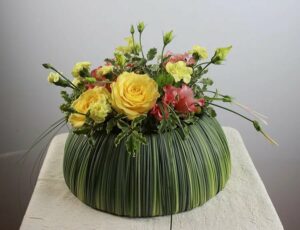 Floral designs:
Floral designs:
Floral design or flower arrangement is the art of using plant materials and flowers to create an attractive and balanced composition or display. Evidence of sophisticated floristics is found as far back as ancient Egyptian culture. A commercially designed floral design, arrangement, or artwork includes the elements of floral design: line, form, space, texture, and color, and the principles of floral design: balance, proportion, rhythm, contrast, harmony, and unity. There are many styles of floral design, including botanical style, garden-style (hand-tied, compote or armature), verdant desert, nose twist, pot au fleur, inverted «T», parallel system, western line, hedgerow design, mill Day huh included, Fleur, and formal linear.
The commercial floral industry as it is today is influenced by the Eastern, Western, and European styles. Ikebana is a Japanese style of floral design and includes the three mainline placements of heaven, human, and earth. In contrast, not just blooming flowers, the European style emphasizes the diversity of color and botanical material, in mass gatherings of many flowers. The western design has historically been characterized by symmetrical, asymmetrical, horizontal, and vertical styles of arrangement. In addition to flower arrangements, the floral design includes making wreaths, knots, garlands, festoons, boutonnieres, corsages, and bows. The houston floral delivery also provides the beautiful sunflower bouquet houston and wedding bouquets houston.
Dried arrangements and related media:
Permanent creations and components which consists of dried materials such as wood, dried (and often aromatic) inflorescences, leaf skeletons, artifacts, bark, dried flowers, leaves, and preserved materials are some of the common extensions of the art floral designs and are of practical importance in that they last sine day and they are not dependent on any of the seasons. Their ingredients complement, and conversely, provide effects, idioms, and associations for fresh flowers and foliage.
Schools:
The floral industry continues to grow with the ever-increasing interest in the natural world and flowers. The increase in educational institutions providing training in floral design has resulted in many state universities as well as certified design schools around the world.
Associations:
The Society of American Florists (SAF), the American Institute of Floral Designers (AIFD), and the National Association of Flower Arranging Societies (NAFAS) are some of the Prominent industry associations that promote floral design worldwide.
















